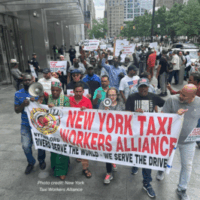Nationwide—An analysis of new data from the Bureau of Labor Statistics reveals that the unemployment rate ticked up to 4.2% in July, while 7.2 million workers were unemployed. The unemployment rate for Black workers increased from 6.8% in June to 7.2% in July, compared to a rate of just 3.7% for white workers. The unemployment rate was 5.0% for Latinx workers. Asian workers’ unemployment rate was 3.9%. Continuing disparities in unemployment rates are a result of structural racism in the U.S. labor market, including persistent occupational segregation.
“As the job market begins to weaken, the quality of jobs must also be an urgent concern,” said Rebecca Dixon, president and CEO of the National Employment Law Project (NELP). “Workers are facing a range of harms as employers increasingly use digital technologies to assist with management tasks such as monitoring employees, setting pay, evaluating performance, and disciplining workers. Without transparency, safeguards for accuracy, or recourse for workers, the growing use of ‘bossware’ technologies, including artificial intelligence, is making existing workplace abuses worse. Policymakers must act to protect and empower workers.”
A new report, “When ‘Bossware’ Manages Workers,” by NELP experts Irene Tung, Paul Sonn, Maya Pinto, and Josh Boxerman, describes how workers in a wide variety of industries—including nurses, call center agents, warehouse workers, and hotel housekeepers—are facing an intensification of workplace problems such as unfair discipline, dangerous workplace conditions, discrimination, and exploitative pay and scheduling practices as a result of employers’ use of digital surveillance and automated decision systems. For example, workers report “a significant loss of autonomy in how they do their jobs, and a devaluation of their professional expertise and skill… [as] bossware allocates tasks, prescribes rigid directions for task completion, and punishes them if they deviate from those mandates.”
The industries that added the most jobs in July included health care and social assistance. Workers in these industries are among the two-thirds of the workforce that researchers find experience digital surveillance and monitoring in the workplace.
The federal government experienced the greatest job losses in July, with 84,000 jobs lost since January, a direct result of the Trump administration’s firing of public servants. Manufacturing lost 11,000 jobs in July.
Technology should be used to improve rather than degrade working conditions. To advance this goal, policymakers should update, expand, and enforce existing workplace protections including laws that promote worker power and employer accountability, workplace health and safety, fair pay, anti-discrimination, and the right to organize. In addition, policymakers should regulate the use of bossware directly, with a particular focus on how this technology is used in discipline and pay. NELP’s report details more specific policy recommendations.


